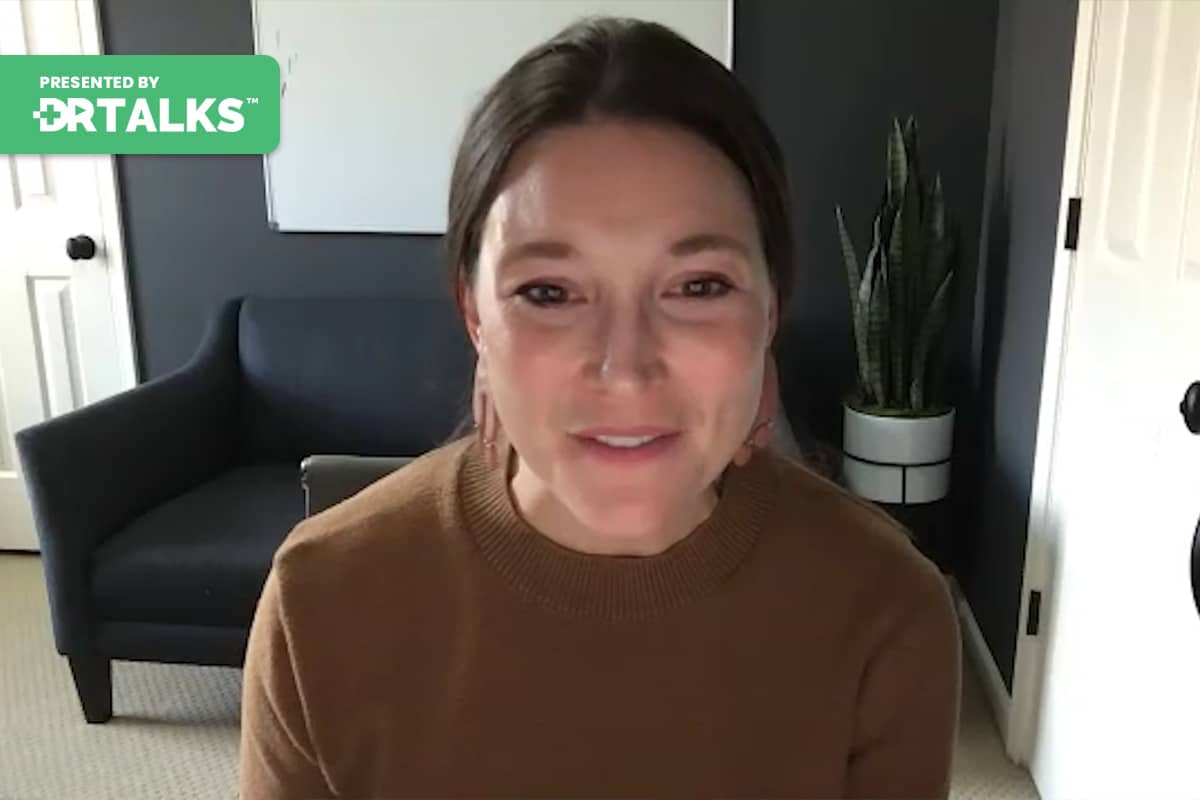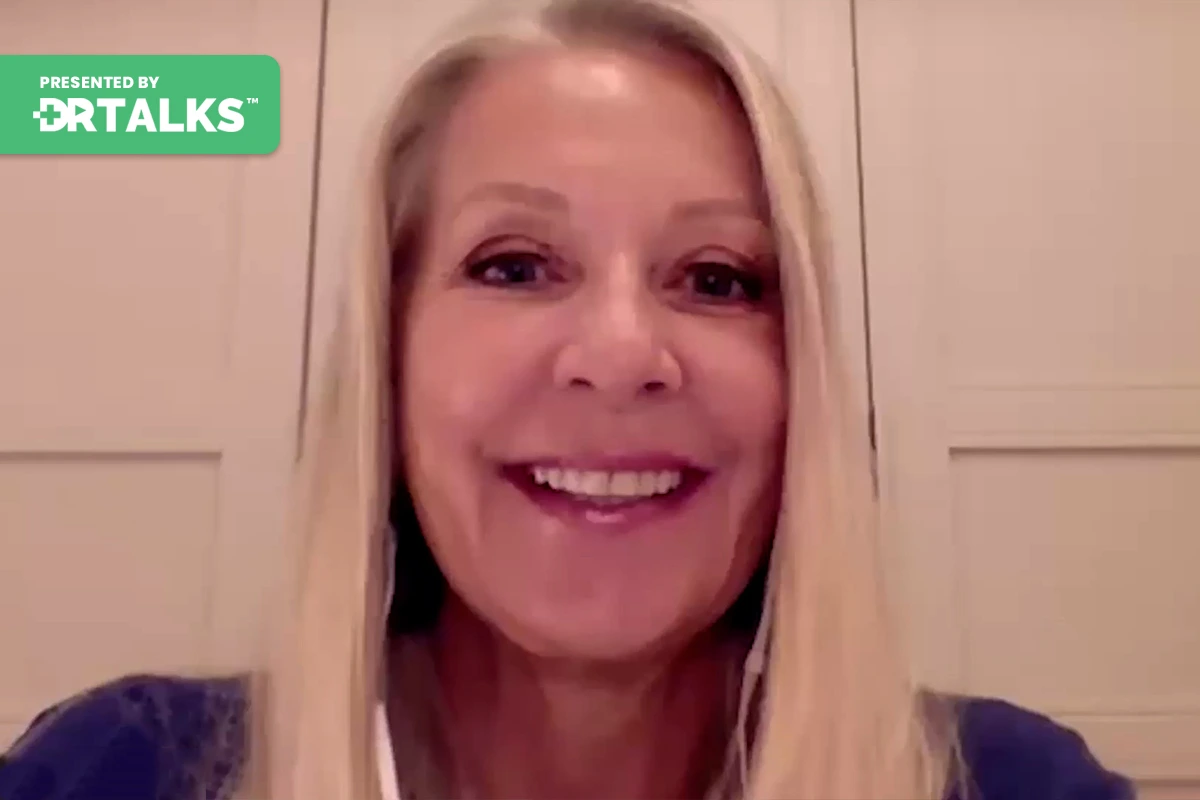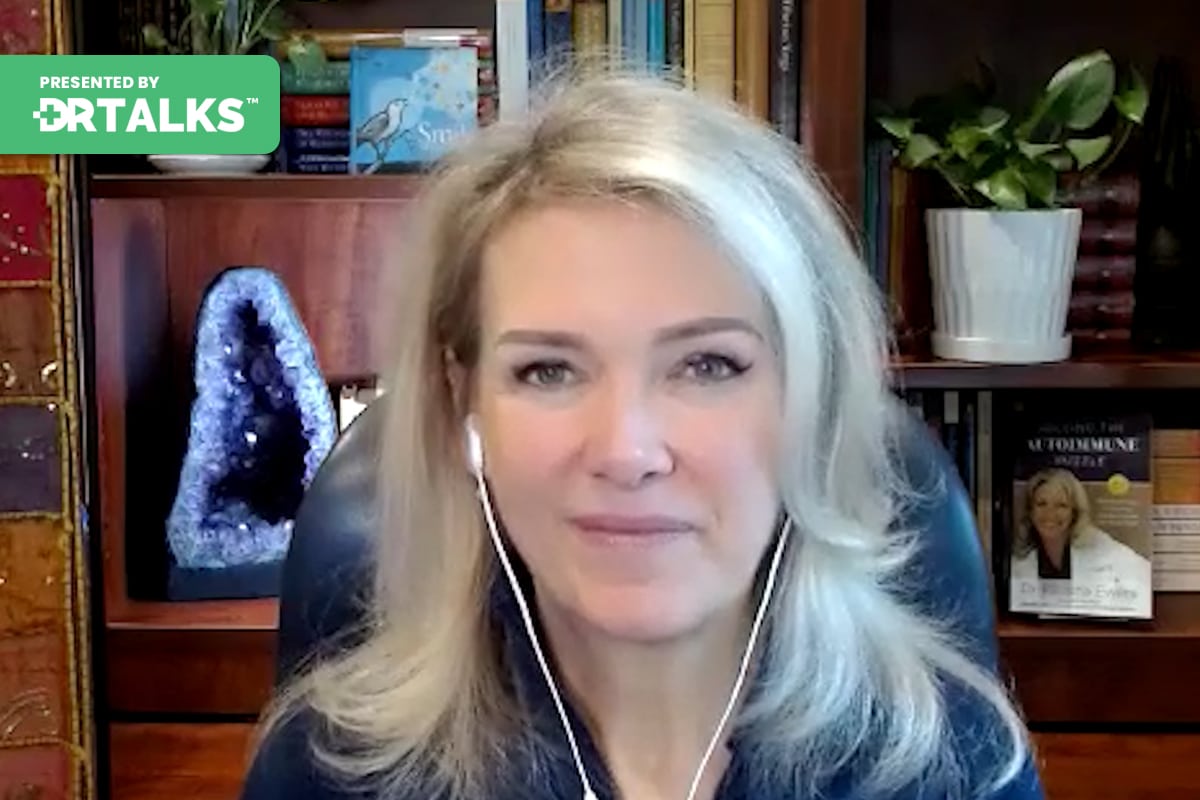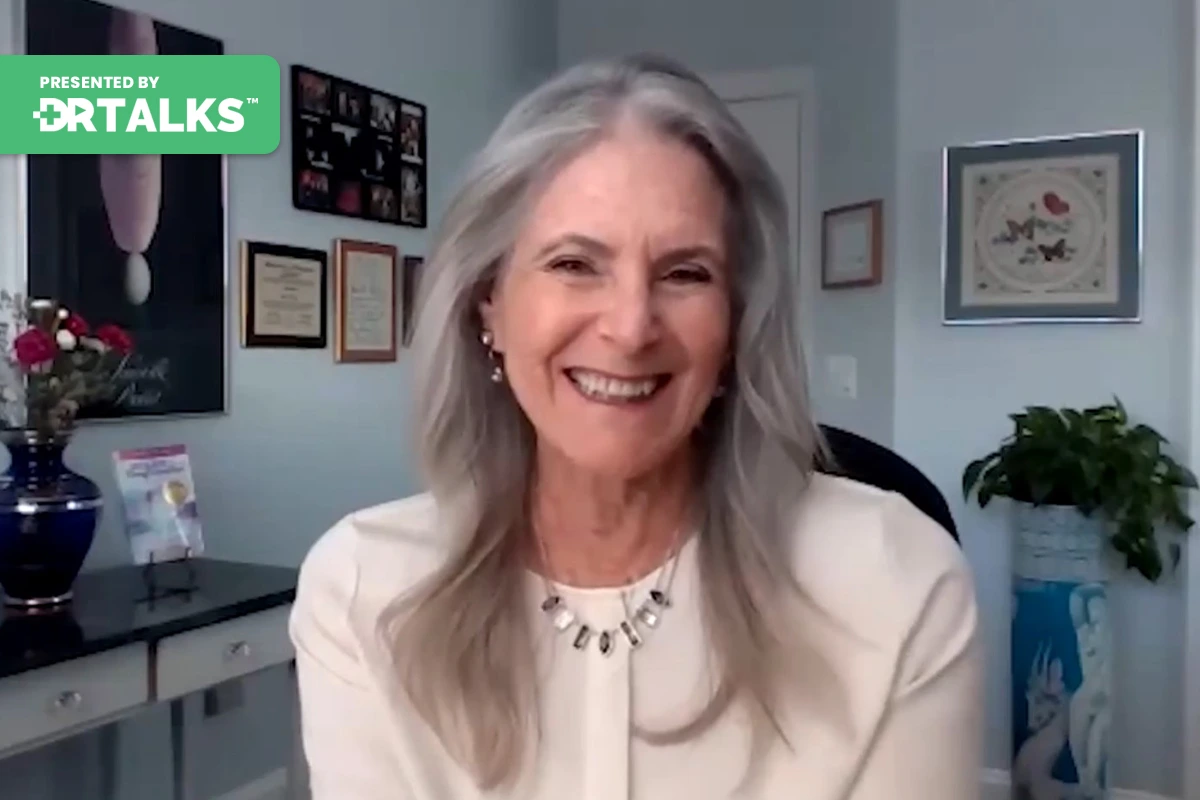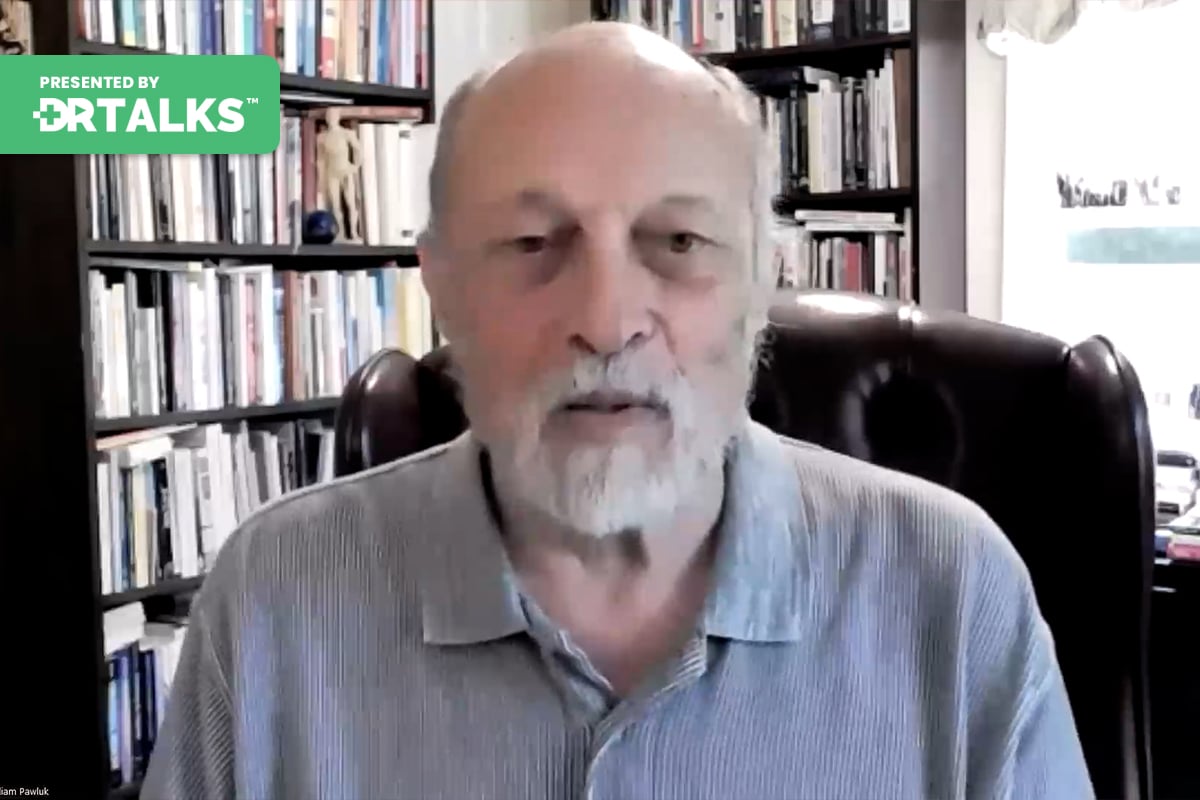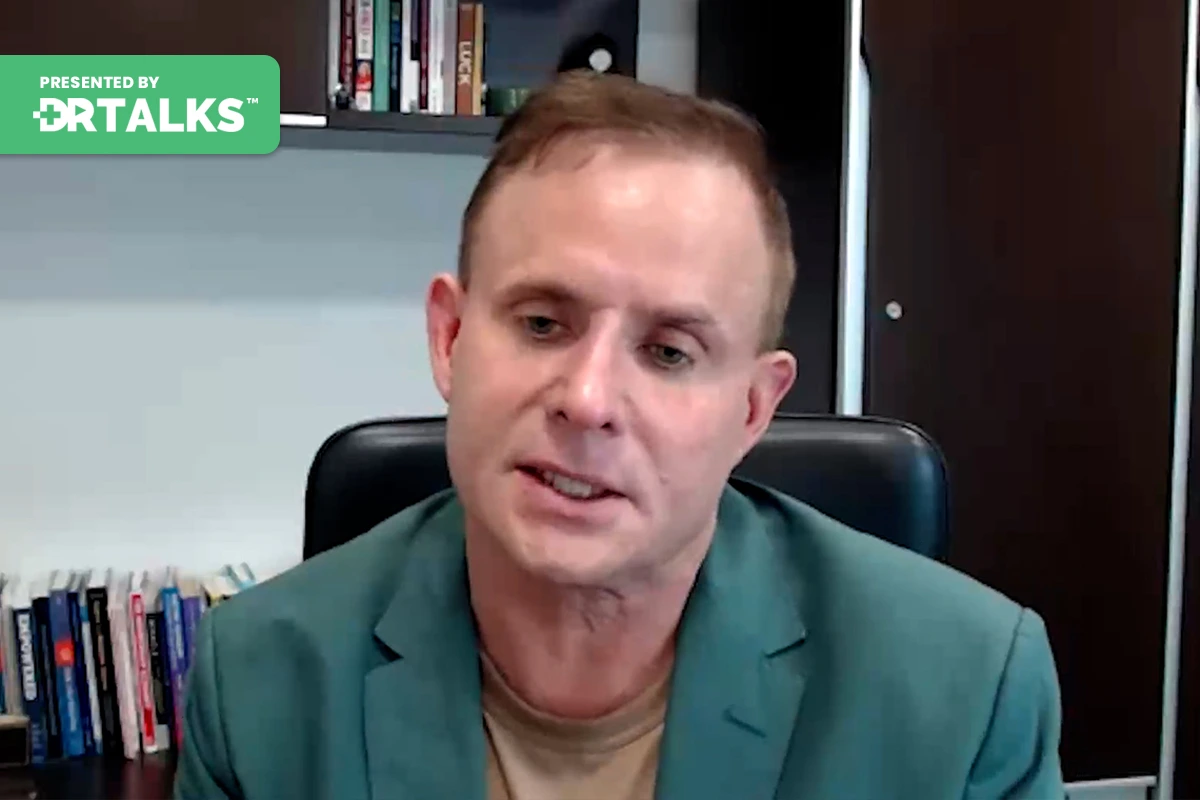Join the discussion below
- Lifespan vs. healthspan, what to focus on to increase healthspan
- Inexpensive test to run to evaluate our biologic age
- Tips and tricks to become the best version of ourselves TODAY
Michael Karlfeldt, ND, PhD
Well, Kristin Oja, I’m so excited to have you on this episode or this segment of the regenerative medicine summit. Thank you so much for joining me.
Dr. Kristin Oja
Thank you so much for having me. I’m excited to be here.
Michael Karlfeldt, ND, PhD
Well, so just for people out there let you know all the amazing things, let them know all the amazing things you’re doing. Dr. Kristin Oja is an entrepreneur, functional medicine specialist, doctor of nursing practice, founder and CEO of stat wellness and well, we’re gonna talk a little bit about stat today and mother to two under two, wow, that’s you’re still alive and you’re still sparkling and you’re you’re doing great as that wellness is the nation’s first medicine and movement practice that takes a proactive approach to your health by combining the best practices of functional medicine and strength training. There are two locations in Atlanta and Roosevelt, Georgia with a third on the way in Peachtree City. I want to live in Peachtree City that sounds like a cool place to be.
Dr. Kristin Oja
It is an awesome place. It is actually a golf cart community. They have about 100 miles of trails that you can run walk golf cart. So we will have a stat wellness golf cart to do mobile I. V. S. So we’re super excited to be a part of the Peachtree city area.
Michael Karlfeldt, ND, PhD
How cool! So actually mobile ivy. So while you’re, you’re kind of on the golf cart. You got your I. V. Going.
Dr. Kristin Oja
Oh yes, you can take it, we can take it to people’s houses to businesses. We’re gonna get the golf wrapped. Yeah it’s very Peachtree city. So if anybody listening is from the area you will be able to very much relate otherwise. It seems very foreign that you would do golf cart I. V. S. But yes it is. We’re excited about joining Peachtree city.
Michael Karlfeldt, ND, PhD
I love it. That’s awesome. So tell me about stat wellness. I mean you’re doing obviously movement and integrative functional medicine to combine the two and it’s all under one roof that you’re doing this right?
Dr. Kristin Oja
Yes. Yes. So we our goal really was being a one stop wellness shop and having a lot of points of contact with our patients. So prior to starting start wellness. I worked in other functional medicine practices and I loved what I did but I saw my patients you know once twice best case scenario three or four times a year and a lot of them would drop off. They would know like this is what and I talked about and they may for a week or two be really gung ho and excited about all of it and then they would drop off and when I would see them they couldn’t remember how they were feeling three months ago to know if they were feeling better and then they also were like yeah I did really well for a couple of weeks. But then I totally like I don’t know what happened but I stopped taking my supplements or I just like started eating gluten again. I couldn’t tell if it made a difference.
And so when I opened that wellness, I wanted to create an environment with lots of point of contact. So are memberships include unlimited health coaching, They include four dietitian consults a year, five functional medicine visits, unlimited group fitness. And our group fitness is very much focused on strength training which will be talking about today and it’s created by a physical therapist. All keeping in mind joint longevity, tendon, health ligament, health, understanding that movement is medicine too. So yeah, one stop wellness shop.
Michael Karlfeldt, ND, PhD
I love it. And that is so cool because most of us we think of of health is just like the absence of disease. You know, if I’m not aching anywhere or if I’m don’t have any blood pressure issues or high cholesterol or whatever that is, you know that I’m healthy. So it’s just the absence of disease equals health. But that’s not the case. I mean that’s not what we’re striving for, right?
Dr. Kristin Oja
Exactly. You know, our health span is what’s so important verse lifespan and in order to have a health span, you have to have a lifespan, but you have to have quality of life too. And so one of the big things when we really get into it with our patients are new patients are an hour long and it’s not an hour of like you start with a nurse, you go through everything. You see the provider, it’s like one hour of face to face time with our providers. We go through your birth, we go through every single thing leading up to today. What is a typical day in the life of you look like, how do you feel when you wake up in the morning? Are you tired at three o’clock? Do you want to take a nap? Are you feeling tired and wired at night? Do you crave some chips in mid afternoon? You know, do you need that coffee to get out of bed and a lot of times going back to what you just said, the absence of disease is not health. When you talk with them, they put in their paperwork, I would describe my health is excellent. I don’t take any medicine, but when you talk with them, they’re tired.
They’re needing caffeine, they’re wanting wine at night to calm down there, taking a sleeping pill, they take traZODone at night. Then you know, it’s, it’s these different things where you’re like, yes, I know you don’t, you haven’t been labeled with the disease and you classify your health is excellent, which I really appreciate. But it goes back to our that you and I were talking about with our logo in the middle. There’s trying and it’s a mind body spirit and there’s a gap and there’s room for improvement in us all. And so you know, for that patient, I have an opportunity to support their energy to make them feel like they’re not dependent on caffeine to hopefully over time and there’s nothing wrong with taking traZODone if you need it for sleep. But over time, how can we get you naturally making enough melatonin? How can we get you sleeping without traZODone? And those are kind of long term goals with our patients.
Michael Karlfeldt, ND, PhD
Yeah, because I have a lot of patients, they come to me and they say I was an excellent health was perfect. You know, felt great. And then all of a sudden I have pancreatic cancer, you know, so, so it’s the importance and it’s becoming more and more important now to kind of continually monitor these different markers to see where your body’s at and have, you know, check. So what kind of labs do you do? You run to monitor and say that? Well, these are the things I know you say you feel great, but here we have room for improvement. So what are some of the things that you look at? 22 can understand that.
Dr. Kristin Oja
So the thing I tell people is we can do all the fancy functional medicine. Cash pay test. You know, we can do the stool analysis, we can do the dutch, the dried urine tests, look at your hormones, we can do food sensitivities. We can do all of these things. But at the core some of these really basic inexpensive markers are so important as we’re talking about longevity. And one of my favorite markers is a basic lab called a CRP. A CRP is the c reactive protein, which is a vague marker of inflammation in our body. And we know inflammation, chronic, low grade inflammation is the silent killer and it’s what’s aging us and it’s what’s leading to so many different diseases. And we don’t settle for any c reactive protein in the body. So our patient that feels excellent comes in their CRP is three. You know, they changed the regular CRP quantitative to be a range of 0 to 10 because I don’t know if you or any of our listeners know where reference ranges come from, but they take everybody’s levels. They put them on a bell curve. They say this person is abnormal and this person is abnormal.
And as Americans are becoming more and more inflamed. R. C. R. P. S. Are normalizing the inflammation. So what was 78 years ago? 0 to 5 is now 0 to 10. And so are patients that are eight with their primary care are normal and nobody even thinks anything of it. But this marker c reactive protein is dollars to run. This is a very inexpensive test and we want it less than one. We want no inflammation in the body. Any degree, even two. We’re having some signs of inflammation and that’s where we come in and we want to figure out what’s driving it and how can we reverse it and how can we measure it and show you that it’s coming down. That’s one marker. The other really big ones that I talk about when it comes to longevity and disease prevention is blood sugar control. And this is where we can get a little bit fancier but there’s some basic things fasting glucose. A hemoglobin, A one C which is a three month average of blood sugar control and insulin which is the hormone that pushes glucose into ourselves to be you For energy. Those are three very very inexpensive tests that I encourage you not to be okay with the reference range on these markers. So for fasting blood sugar I want it under 85.
We wanted between 70 and 85. There is research that every point above 85 is increasing your risk of developing diabetes down the road. So you know the person that comes in at 95 technically normal. The ranges up to 100 but 95 is increasing your risk of developing diabetes later in life. So 70 to 85 chemical but a one C that’s your three month average. We really want it somewhere between five and 5.2. You know, you could be at 5.6 and almost straddling the line of being prediabetic and be normal. You know that’s a pretty high glucose average over a three month period. Even though you’re not prediabetic and diabetic and then insulin, this one blows my mind that the reference range goes up to 24.9. So you could wake up with a fasting insulin at 18 and you could be very normal and you haven’t eaten in eight hours, 10 hours, 12 hours. And we want that to be under seven. And the reason is when we’re fasting and we have a low insulin, it’s correlated to lower inflammation.
But we’re also able to make more glue Kogan naturally. And for any of the listeners, you may have some people talking about this in the longevity space. Those m pick the Blagov these glue gone like peptides that are really helping with weight loss and helping with brain health and anti aging properties. You know, these things help reggae our blood sugar. And so we want to naturally be making more Glueckagan. And in order to do that, we have to get our glucose and insulin down. We gotta move that seesaw right? So these are very inexpensive markers that are so tightly correlated based on evidence as it relates to our longevity in the aging process that we check on every single person.
Michael Karlfeldt, ND, PhD
And yeah, and that it’s a very important point that you’re making in regards to lab tests. I mean we there’s such a huge range of what’s considered normal. And but what you’re saying is that they are then using sick people to include in those tests and they are part of the average and none of us want to be average of a group of sick people we want to live optimally. Right.
Dr. Kristin Oja
Exactly. And once these markers are flagged off, we have a disease state. You know, once your CRP is 11, there is a disease state going on. You know, that’s we want to be proactive, we don’t want to be reactive and we do catch people. I mean, I have patients coming all the time that have never been diagnosed with anything and I check their CRP and it’s 22 you know, and they have no idea that they have inflammation in their body and that is again a very inexpensive test. And that was so eye opening to my patients that thought they were feeling well and they’re walking around with pretty significant, I wouldn’t even call that low grade inflammation. They’re walking around with significant inflammation, which is damaging ourselves, increasing our risk of cancer diseases, autoimmune diabetes. You know, the list goes on and on.
Michael Karlfeldt, ND, PhD
So, if I’m hearing you right, you can have these elevated c reactive protein CRP and not really feel anything. You know, because you would think that if you’re inflamed well, shouldn’t have like arthritis or shouldn’t I feel a key in pain. But you’re seeing then that you can be elevated inflammatory markers and still feel normal.
Dr. Kristin Oja
Yeah, for sure. I’ve seen both. I mean, we’ve had people that have mildly elevated crp s like we would consider you know a four and they come in and they their hands are stiff, their knees hurt. So you know it’s not always correlated to how you feel like we have low normal CRP. S and people feel super inflamed and we have people that we catch that are really high and they feel okay. And I think it depends on you know, CRP is such a vague marker. You can have very localized inflammation around joy or things like that that maybe is not directly correlated to where your CRP is at. But yes I have had multiple patients come in with significantly elevated CRPs and have no idea. They’re also the patients when I dig into more of their heart health markers that you know they’re standard lipids like okay but they’re small LDL particle, their total particles are through the roof. You know I end up sending them for a ct calcium score and their ct calcium scores in the 400. I’m getting them in with cardiology.
You know there it’s like once you start looking sometimes you find a lot more than you anticipate but that’s what saves lives and that’s what prevents us from being like oh now you have an M. I. And now we need to do a stint and now we need to put you on cholesterol medicine, you know we can pick up on these things early. And my favorite favorite saying is a Tanzanian proverb that is little by little a little becomes a lot and knowledge is power. So once we know where your baselines that we can make small, simple changes over time that are going to lead to total body transformation. You know, this is, I always tell my patients were not looking for one magic pill if you are, it’s gonna come with side effects. There’s gonna be another issue behind it. Like it is the little things we do consistently that are going to impact our health the most.
Michael Karlfeldt, ND, PhD
And and that is to develop patterns, develop and develop a lifestyle that is sustaining good optimum health and like, like you’re saying it’s not, yes, I do take this one supplement or I do this, you can’t compensate for poor living, doesn’t matter how many pills you take, you just can’t compensate for it. And in regards to people don’t understand that the body is, is such an intelligent and amazing piece of machinery and it, when things is getting off kilter, it has all these compensatory mechanisms to try to compensate for what is thrown off and and symptoms do not show up until the body can’t compensate anymore. And so then by throwing a pharmaceutical on that to try to shut down when the body is finally to telling you, hey, stop, wait, you know, we need to fix something now we throw a medication on it to silence the body instead. You know, we should then look under the hood and see what areas do we need to address and we want to address it before the body is running out of ways to compensate.
Dr. Kristin Oja
Exactly. Exactly. And it just takes the time to gather the history to know what to order and then to be able to have the conversation like our model. This is also what’s really interesting to me is you go in for a physical, they draw your labs and then you get just the message back that everything looks good or lipids are slightly elevated. We don’t need to start medicine right now. I’ll see you next year. We’ll check them again. Now next year comes around now they’re higher. You know, I’m gonna go ahead and call this prescription in but it’s always this reactive approach where the labs are coming back. So for us, we want to draw the labs and we want to meet and we want to have a conversation. What do these things mean? Where are you within the normal range and where are you within the optimal range and what are some things that we can start doing today to shift our focus to our health span and put, you know, the health back in health care.
Because the thing I tell people and I don’t want any listeners to get me wrong, we have some of the best medicine in the United States, like if you were to get diagnosed with Cancer if you need a surgery or, you know, a hip replacement, we have some of the best medicine here in the United States, we are great at sick care. But I think every single person, even the providers in the sick care world would agree that our health care is really suboptimal because of our insurance model time that we have with patients. You know, it’s and I don’t blame them. I don’t blame primary care at all. If you’re seeing 40 patients in a day, You are providing sick care, you know, that is reactive because you have 40 patients to see in a day.
Michael Karlfeldt, ND, PhD
Yeah, and all they’re doing, like they’re saying either, you know, here’s a pill, you’re complaining about something, here’s a pill. If they can’t see anything in the blood test, it’s probably psychosomatic. So here’s amount of depressants. Yeah. And that way you’ll feel better and you don’t have to worry about things. And yeah, so you’re, you’re absolutely right. And frequently when people get labs, you know, I have patients coming in and said, yeah, my primary they ran these labs and I haven’t heard anything from them. So I guess I’m okay, you know, and they never get to see their own labs and they don’t, you know, so if it’s that personal engagement in your own health that is really underdone in, in the sick care models. So that I think just that one thing to become empowered and become engaged and become active in your own health and take the appropriate steps and work with somebody that is coaching you and guiding you along so that you can reach your optimum goal. That’s huge.
Dr. Kristin Oja
Well, it’s hard when you try to do it on your own. Like I know you probably have seen the patients that they are so invested in their own health. They probably have read more research studies about, you know, vitamin D and knack and glorifying recently than I have and you know, they’ve tried all the things but they don’t have that partner that they can talk with and trust. And I can tell I tell my patients, I can find a research study to support almost anything that you want to do, but we have to look at your values and we have to take an individualized and customized approach of what you need. You know, this is true from an airman fasting standpoint from a should I run marathons or do hit training or strength training, you know, our chemistry, our hormones, our season of life dictates a lot of that beyond what you read in a research study.
Michael Karlfeldt, ND, PhD
Yeah, I agree. So let’s say an individual that do the c reactive protein test that’s elevated or they do the glucose, the A one C. And it’s, you know, 5.6 and we want it down to the 5.2. So what is your approach to that? I mean how do you address that?
Dr. Kristin Oja
So I think number one we want to and hopefully at this point we’ve already kind of uncovered some of the potential root causes because we want to identify. And so even starting, you know, we believe in a pyramid at stat and the base is lifestyle just as you mentioned earlier, the second tier is supplements and hormones and the third tier is pharmaceuticals. So we go back and we’re like okay you came back and your A one C is at 5.6, you were eating really well and you are exercising regularly. Like I am so proud of you for like the way you eat, the way you exercise. I don’t think the solution is that you need to eat less and exercise more. You know I had the conversation, we went through their weekly routine but you know what I identified through our conversation you were very very stressed out and I really believe after looking at all of your labs that stresses the root cause of your blood sugar issues and possibly even the inflammation. So I’m gonna start with stress management for you and part of that may be doing some functional testing and really being able to show them through an adrenal saliva test, you know, where is your cortisol throughout the day?
Sometimes it’s just getting some good first thing in the morning cortisol, D. H. E. A. Sometimes it’s not doing any of that and it’s just working on the stress management. They’re like, yeah I would agree. I do feel like I exercise well and I eat clean but I feel stressed and anxious the majority of every day. And so we may work on basic things like deep breathing and setting boundaries and turning off electronics an hour before you go to bed and you know, taking a steam shower and putting essential oils at the bottom. You know, basic things that we know can make a difference or you know, maybe and this is something that I always say controversial because there’s great research for this. But when I talk with my patients, these are the people that are doing all the things. You know, they are high performers at work. They’re training for marathons. They’re intermittent fasting, they’re drinking coffee because they need to have the energy, you know? And so when I look at it, I’m like on paper, you’re doing all the right things for your health.
But when we break it down and I look at just your morning that is so cortisol driven, you haven’t eaten at all. You’ve had no fuel until one o’clock. You’ve had only coffee, you ran 10 miles, you woke up at five to fit it in but you didn’t go to bed till midnight because you were working then you were going to your job and I’m like yeah, you haven’t even eaten anything and you’ve exercised. But that cortisol is impacting your inflammation and it’s impacting your A one C. So can we switch to, you know, half decaf half regular coffee. Can we maybe eat a little bit of something with protein before? Can we, if you want to run 10 miles in the morning, can you go to bed a little bit earlier? So you get that 20% deep sleep you need for your recovery to prevent injuries, you know? So that is just an example of how we would work through this. And sometimes, you know, it’s the opposite. Someone comes in and they’re like, yes, I do not move at all. I don’t have time to exercise and I go through fast food three times a week.
And so does my vice. Like I have to drink a soda once a day. I don’t know what it is. It’s like my reward for going to work at lunch. Like, you know, I was just talking about patient about that yesterday. She’s doing everything right. But she has that soda at lunch and she doesn’t know what it is, but it is her reward for making it to the office and going out to lunch with her colleagues, you know, So that is going to look very different. So this is exactly the kind of presentation and why a personalized approach is so important. We cannot just get these labs back and tell people you need to eat less and you need to exercise more. I’ll see you next year.
Michael Karlfeldt, ND, PhD
It doesn’t work. It doesn’t work at all.
Dr. Kristin Oja
No.
Michael Karlfeldt, ND, PhD
No. No. And do you think somebody can be exits? So you’re talking about this this type of a person that does everything perfect and adrenal. I mean cortisol driven adrenals are yeah. He’s really kind of utilizing every possible squeeze out of those adrenals and to get the extra cortisol that he can. And do you feel sometimes people then can be exercising too much and that’s why the glucose level or a one C level is higher.
Dr. Kristin Oja
Yes, for sure. And we know this for sure because we use a lot of what’s called C. G. M. S. Or continuous glucose monitors. And my patients will wear them and they will find, you know that patient that I gave you an example of all morning. Their blood sugar is 1 30 they haven’t had anything to eat and they don’t understand. And this goes back to our physiological fight or flight response right? If the bear is chasing after you and you need to run, you need the energy to keep going. So if you’re starting your day, you know and you’re over exercising under sleeping, overcaffeinated, not refueling and eating. We absolutely see that. And what’s really cool is it doesn’t mean you have to stop exercise. It doesn’t mean you have to stop caffeine, We have to evaluate what is in your stress bucket. What are all the different things, What are you willing to take out? What are you not? But you can’t just keep putting everything in there. And that is like my favorite analogy when I talk with my patients, I’m like, okay, let’s go through everything in your stress bucket. You have an elevated CRP that’s physical stress. You have an inflammatory response to gluten based on your blood work and you eat gluten every single day. That’s in your stress bucket. Your job is stressful.
That’s in your stress bucket. You’re going through a divorce right now in your stress bucket, you’re doing hit training every single day in your stress bucket, you’re having coffee in your stress bucket, you need advance to be able to do your job in the stress bucket. So now let’s talk about what all is in there. What are you know, let’s take out 50% of them. What are we gonna keep in there? Because stress is not bad, right? And I know you know this, but we talk about the stress bell curve all the time. I actually want my patients under some degree of stress because that means they’re becoming a better version of themselves. I want them a little stressed at work because they’re gonna perform better. I want them physically putting their body under a little bit of stress because it’s gonna make them become better if you aren’t putting your muscles under stress, you’re not gonna get hypertrophy. If you’re not putting your heart under stress, you’re not going to keep it healthy. But where is the stress coming from? How many things at the same time? And what impact is that having on our health? So for the listeners, I don’t want you to think stress is bad, stress is good. It’s the only thing that makes us better. But you could have too much in your bucket at one time.
Michael Karlfeldt, ND, PhD
As you were talking about that bucket and everything is being put into it. I just get more and more stress a lot. Poor person.
Dr. Kristin Oja
Yes, but these are things that we see and you know, this is one of the, I was reading a research study the other day that they are now saying and I don’t know if this is all just post pandemic, but 70 to 90% of all medical visits are being correlated to stress right now. Like migraines, constipation, neck soreness, back pain, insomnia, anxiety, depression, blood pressure. You know, we’re in a stress epidemic in the United States and I’m excited that people are starting to talk about it. Like mental health was something we just totally ignored for a while. We’re still not where we need to be, but we’re having the conversations, you know, I know even when I go to take my daughter in every time, you know, I have the two under two. So for all of their, you know, their two month visit, their four month visit, their six month visit. I have to create the questionnaire. You know, trying to evaluate my becoming depressed as a mom. I’m like, you know, at least we have these tools like, you know, this is a standard pediatrician office, at least they’re trying to assess my mental health, you know? So, but we’re people are under a lot of stress right now.
Michael Karlfeldt, ND, PhD
And it’s important to correlate that like you’re doing with inflammation. So recognizing that the stress does have an impact on your body and it is driving some of the major chronic diseases that we’re dealing with, like diabetes, like heart disease, like cancer. And so it is important to understand that to how needed it is to assess your level of stress. That how big, I mean, how full is your stress back bucket and then also correlate that with your health. So I mean, it’s such a key.
Dr. Kristin Oja
Yes. Well, I think at the same time, like we think of stress when we’re talking about mental stress and a lot of times with our patients that we see their bodies under a lot of physical stress from either, you know what they’re eating their lack of sleep. You know, their cancer, autoimmune disease, like whatever it may be our body infection, you know, covid influenza, you know, seasonal allergies. Like there is reasons we can be under physical stress and mentally we’re processing stress very well and it’s the same. It’s still a cortisol response on the body. So, I think that’s really important to just for the listeners is it’s not, you know, you may feel like I have zero stress in my life right now here, but you can have a lot of physical stress.
Michael Karlfeldt, ND, PhD
Yeah. Like you were talking about that type a person. I’m sure they would say that I don’t feel stressed. You know, I’m just because I get everything structured. I’m doing this, doing that and got my goal. Everything is perfect. I’m happy in my life. But the body is saying differently.
Dr. Kristin Oja
Yes.
Michael Karlfeldt, ND, PhD
So tell me how would a person then monitor their adrenal function. I mean, you mentioned, like a saliva testing, is that the best way or is a blood test or why saliva test?
Dr. Kristin Oja
So, this is a little controversial because, you know, in conventional medicine, they kind of believe when it comes to the adrenals to issues, right? You either have Addison’s disease or you have Cushing’s disease. So, you either are not making any cortisol or you are pumping out so much cortisol all day long and a lot of times the way they diagnosis is 24 hour urine cortisol. They look at a hormone called a c th they may do a random cortisol at a random time of day to see is it super high or super low and then do more digging. So they don’t really believe in this in between that you and I are talking about about adrenal dysfunction. You know I don’t like the word adrenal fatigue or adrenal failure because you know that’s really what Addison’s is like what we deal with is a lot of adrenal dysfunction. And so are inexpensive way that we do is we really value time of day when we do labs. So we always have our patients come within two hours of waking. So we start blood draws at seven a.m. To help with this at our office and fasting so that we can see a cortisol awakening response because you can see quite a bit with just the cortisol awakening response.
So some people come in and they’re like oh my cortisol is low, that’s great. Well not really because this is the cortisol awakening response, this is your peak all day, you should be peaking and then coming down as the day goes on. So you know the fact their cortisol is at five and you just woke up an hour ago and you’re feeling depressed and tired. You know this low cortisol to be playing a role and then the same thing is true when the person comes in and in their levels at 26 you know we want it less than you know 19 ish. So somewhere between 15-19 in the morning and they’re waking up with this high cortisol. You know, they’re waking up with this bear chasing after them. They often are the ones that have a high fasting glucose as well. So you can check it very inexpensively. But time of day matters drastically because if you check it, you know, one time at seven a.m. And then the next time you check it at one o’clock in the afternoon, you can’t compare those two cortisol levels at all right from the blood work. So blood work is fine. If you’re looking for massive issues, you could do a 24 hour urine cortisol. In my experience, it’s like, I’ve only caught one person in like 10 years that has a high 24 hour urine cortisol. And then I’m referring them to endocrinology and they truly have Cushing’s, you know, it’s just not a very good indicator, the adrenal saliva, we like, because you can time it, we do saliva and urine.
You know, we’ve done a lot of the same test on the same person and we found the saliva in the urine to be pretty comparable as we’re looking at it throughout the day. So seeing what we’re metabolizing and excreting in our urine and what we’re catching in the saliva. But the reason we like either of those is because we can see the four points during the day and we can follow that curve that I was referring to earlier and then we can be very specific about time of day and what we do based on the results. So you know, if you’re having that cortisol rise at night, this goes really deep even into the blood sugar conversation, it’s gonna impact melatonin production, which impacts your brain telling your pancreas to stop making insulin so your glucose doesn’t drop as you sleep so you can get good restful sleep.
So you know, this high cortisol may just be, oh well yeah, sometimes I’m tired and wired and I take Atrazine dome but this is a deeper issue because the cortisol is blocking the melatonin production and now it’s impacting your blood sugar levels and your ability to get into deep sleep, which again is the most important as we’re talking about recovery. So those are just example. So we would then work on how do we expose you to darkness earlier? How do we turn off electronics? How do we incorporate some deep breathing, some distressing at night? Maybe some stretching and foam rolling. You know, how do we maybe add something like ash Uganda or a lemon balm tea or cortisol manager or something to help lower this. Some of those adaptogens. But I think it’s really important if we know there’s a stress issue to evaluate and quantify it and then to be able to re measure it.
Michael Karlfeldt, ND, PhD
Yeah and that’s because then like you’re saying if you know that, you know it’s not peeking appropriately in the morning, you can then address that and then evening time, you know, if it’s not dropping off, you know, there’s a lot of, a lot of patients, I’m sure you see that a lot, they don’t have enough in the morning and it’s almost like the body is, is kind of trying to get through the day, but then at nighttime, you know, because the adrenals have been trying to get going night time when you’re finally laying down. Now they start working because they have no resistance, so to say, and, and now you’re all awake because adrenals are ready to go because they didn’t have energy to deal with it during the day.
Dr. Kristin Oja
Yes, we see that a lot. We see that a lot, and I hear that a lot with, like, I’m tired and wired, you know, like, I know I’m physically tired, but I can’t fall asleep, you know? So, so there’s ways you can, if you were in tune and actually pay attention to how you feel throughout the day, you may be able to tell me what your cortisol curve looks like. So, you know, a lot of people come in as we’re going through a typical day in the life of you is I’m exhausted in the morning. I’m hitting snooze four times, I have to have coffee, I’m crawling out of bed, you know, chances are you’re not getting this good cortisol awakening response, or maybe, you know, the person, it’s like, you know, I kind of get out of bed, I feel good in the morning, I perform my best, I’m having my coffee, I’m doing whatever I eat lunch and then I take, you know, those are the people that I see where their cortisol stays high in the morning, that has a massive drop off you know, because they’re finally getting what their body needs some of that food and taking the stress off from the low blood sugar, you know, the whole situation. So sometimes you don’t have to do, and that’s the thing that we talk about a lot is if you really pay attention to your body and you’re really in tune and you have a good proactive healthcare provider that you’re working with, you don’t always have to do crazy expensive tests, You can do very basic things.
Michael Karlfeldt, ND, PhD
And talking about since you brought in exercise as is a big component. You know, movement is so important in our health. What should healthy exercise patterns look like?
Dr. Kristin Oja
So I think this kind of goes back to the person and what’s going on with their adrenals and their heart health and inflammation. But the one thing that I think is so clear is that muscle is our greatest asset as we age. So when we lose muscle, we are aging at a much faster, rapid speed. So I always tell my patients, like we do body composition scans not because I care about what the number on the scale is about weight at all. I want make sure I’m helping you maintain muscle because I really believe that is one of the ways that you’re gonna live a long healthy life. So why does it matter? Muscle mass helps protect our joints. Number one. It helps increase our bone density. So osteoporosis, osteopenia, it increases our reaction time, which is decreasing our risk of falls. The more muscle mass we have, the better blood sugar we have and the lower inflammation we have. And this is really interesting to me when you go back to insulin with what we were talking about before is insulin is really thought to be an anabolic hormone. It really helps with building. Right? So insulin pushes glucose hopefully into your muscles to help you build muscle mass. But in a lot of our standard American diet, in our standard American lifestyle, what are we doing instead of having the insulin pushes glucose into our muscles?
We’re pushing all of it into our fat cells and then we’re getting into this surplus. So, strength training can actually help from an anabolic standpoint of a building muscle mass standpoint and better regulate our blood sugar, which is so critical. It’s also as we think about the aging process when you strength train, you’re increasing your ability to have functional independence, right? Like strength training when you do it correctly is functional movements When I have a patient that comes in and tells me that they were told that they can never deadlift. I sit there and I look at them and I said, well do you ever bend over and pick anything up? You’re doing a deadlift? Right. So when we are told or patients are told that they can never deadlift, we’re doing them a disservice of their functional independence. Now, does everybody need to be maxing out with the barbell working to a one rep max of 400 pounds?
No, but we need to be able to safely do a deadlift with some weight, some degree of weight because we pick things up off the ground. You know the grandparent that’s picking up the grandkids and keep throwing their back out because they were told they could never dead lift and so they haven’t those muscles. So when we strength train we increase our risk of having functional independence, which is so important. And the more muscle mass we have the leaner. We are in general because of the blood sugar ability. And when we are leaner and we have less fat tissue, we have lower inflammation. It’s very well studied the adipose tissue, visceral fat drives up crp. So, you know, all of these conversations we’re having around are three keys of longevity blood sugar control. Really having an optimal inflammation. Super low strength training is one of the best tools to help us achieve those things and our muscle is our greatest asset as we age.
Michael Karlfeldt, ND, PhD
And so what is the most, it sounds like strength training is key. How about aerobic exercise? Is that part of it as well do you feel?
Dr. Kristin Oja
Yes. So aerobic exercise I think is very, very important. I do not think it needs to be marathon running, but we do need to, as we were talking about earlier, putting stress on our heart we want. And one of the ways we know our kind of health overall is based on our heart rate variability. So that looks at how resilient are we destroy, how healthy is our heart and in order to have a healthy heart you have to utilize heart rate variability. And how do you get heart rate variability? You increase your heart rate and you decrease your heart rate so you need the exercise and you need the meditation and mindfulness and good quality sleep to overtime have good heart rate variability. But I do think that there are some people that take it a little bit too far and it’s all, you know, marathon training, it’s an hour long of hit training. We really know that isn’t what it needs to be. When you look at the American Heart Association guidelines, if you’re doing vigorous exercise, vigorous cardio exercise, you only need 75 minutes a week. So when you think about this vigorous high intensity exercise, 75 minutes is what they find is great for heart health. Now, when you bring it down to moderate cardio or moderate intensity workouts, you need 150 minutes. So now you’re looking at about 30 minutes five days a week. But if you think about 75 minutes of vigorous exercise, that could be 325 minute blocks of high intensity interval training.
So I think you have to kind of look at the balance and what are your goals at the time. But there is an interesting study that was really good that I was just reading that talked about how there is benefits and adding exercise at all ages. And they were looking at this and people that were over 65 and even over 85 and they found, and this is to your point of why cardio matters. And I really believe strength training is so critical. But the people that met the muscle and the strength training goals, they had a 10% reduction in all cause mortality in the study. Those that met the Aerobic goals had a 24% reduction in all cause mortality. And those that had the strength training and the aerobic exercise had a 30% reduction in all cause mortality. So, to answer your question, both is best. Right? But look at what is kind of the recommend, what is the goal? What is going to help with a healthy heart?
And I just I find in my patients when they’re doing an hour long hit training 56 days a week, I see more negative. There was another study that was done in college students. So not maybe as relevant to the rest of the world, but they looked at the people that exercise across the board, low moderate and high intensity all decrease the risk of depression and college age students. But they found that low intensity and moderate intensity exercise lowered inflammation and improved depression where high intensity exercise reduce depression but increased inflammation. So, you know, I think the intensity does matter and part of that is when we push ourselves really intensely. You do trigger inflammation, that’s part of it. But you hope your body is able to compensate and heal from that depending on what’s in your stress bucket.
Michael Karlfeldt, ND, PhD
And you talk a little bit about persecute inflammation, which is what you get from exercise is can be beneficial. But then you have, what you talked about earlier is that chronic inflammation that’s there continually. So talk a little bit about that. What’s the difference?
Dr. Kristin Oja
Yeah. So acute inflammation is typically, I’ve never read a situation where it’s not a good thing, acute inflammation is your immune system and inflammatory cascade, working the way it should. So even outside of your example of exercise, which is an acute inflammatory process, rolling your ankle, you know, you want your ankle to become inflamed, that’s your cytokines, your healing cells coming to the area to help you recover. So that is all positive acute inflammation. If you were to get exposed to the flu, you want your body to become inflamed because it’s activating your immune cells and it’s saying fire, fire, fire, let’s get rid of this flu, let’s recover. Let’s get back to our baseline, calm down. The immune inflammatory cascade. All of those situations is a healthy immune and inflammatory cascade. The low grade chronic inflammation is the problem. And actually when we check CRP s, it’s also really important to us that people don’t exercise the morning of their lab draw, so they wake up, they just drink water and they come straight in and get their labs drawn because I want to see what does your baseline look like. And sometimes I do have patients that are over exercising and overtraining and their crp is still elevated and it’s an opportunity for us to talk about recovery and why we need a little bit more.
And I love, I don’t know if you’ve used the band, but for my patients that I do feel like over train, the band takes the work out for me. Like they see their recovery each day, you know, and they’re like, oh my gosh, I’m only 33% recovered, they can see start to see they’re increasing their risk of injury and they won’t be able to sustain that level. They naturally start making all the behavior changes I want them to. It’s also super cool when people wear the band, they’re like Kristin, I didn’t know that one glass of wine I drink every night impacted my sleep and recovery as much as it did. So now I don’t drink it all Monday through Friday. Like I don’t have a single drink and my recovery went from 75 to 92% by just giving up that glass of wine. And so I’m like I love this objective data. It just does our job for us. Same thing I put people on a C. G. M. They stopped doing their afternoon snack.
They started to see what the potato chips in the afternoon we’re doing to their blood sugar. They stopped eating the potato chips and it wasn’t even me telling them. So you know I think that it’s really important when you’re looking at CRP to see that. So it’s really important when you’re going in for your labs that you’re not exercising putting stress on your body because that stress with exercise is good. But if it’s been 24 hours since you worked out and your CRP is still high from that workout from our opinion. You overdid, you know that’s a little bit too much if you’re still inflamed but it is the chronic low grade inflammation that is driving up the autoimmune disease, the cancer heart disease and all of that and that’s what we’re referring to with the C. R. P.
Michael Karlfeldt, ND, PhD
And with the recovery and people don’t recognize how important recovery is because it’s not when you’re exercising you’re building muscles or building strength. It is when you are sleeping when you are. That is that is the recovery that’s taking place. And obviously things like wine and doing the chips to create this regulation your blood sugar is not going to support and production of the different hormones that’s needed while you’re sleeping to repair all your muscles and all your tendons and all your ligaments. So now you’ve just done all this exercise spend all that time and you’re weaker.
Dr. Kristin Oja
Yes you’re exactly right and there are the patients to that over time they end up having an injury and then they can’t look out for six weeks and they’re forced into recovery you know and then they’re mentally struggling with the fact that they can’t exercise. So I do find that it’s sometimes hard and I don’t know if you see the same experience with these patients that are at the Taipei that do everything really well. That’s where I really encourage you know let’s wear a C. G. M. or let’s get a whoop band because they need the objective data to make the behavior change. And that’s where it just again I just think that it does my job for me I love it.
Michael Karlfeldt, ND, PhD
So what what I know we’ve already covered a lot of tips you know that that people can do, they can take home and create those changes in their life and and talk to their provider as to, you know, these other things that I want to see and I want, I want to be engaged in my own health care. What are some additional things that we haven’t discussed that you feel are are things that people can do now to start to improve their health?
Dr. Kristin Oja
So I think one of the really big things is think about the pillars of wellness. You know, we’ve talked about a lot of these, where is the area that you feel like you have the most room for improvement? Is it your sleep? You know, we really want 78 hours of sleep. So when you’re hearing all of this, are you not sleeping? That’s what I would prioritize from your tip. Is it diet? You just know like I don’t eat enough during the day. I definitely don’t get serving six servings of vegetables a day. You know, I’m not eating good sources of protein. You know, it could be nutrition and your goal could be, I’m just gonna start eating one serving of vegetables with each meal. You know, I’m just gonna start there. This goes back to a little by little. Little becomes a lot is your main thing stress. Are you like? I really feel like lifestyle wise, I’m doing well, stress is my area, start with some deep breathing every morning, every night. Just slow down your breath that taps into the parasympathetic state that rest and digest. Just slow deep breathing. Maybe yours is more relationships, maybe it’s exercise. So you have to look at the wellness pillars and figure out because the biggest thing that I hear people think all the time is I got to do all of it tomorrow.
So then they try to do it all at the same time. I’ve got to go to bed earlier. I need to drink more water. I need to eat more vegetables. But there is an area that you that was going to have the largest impact because you have the most room for improvement. And if you start there and master that and have really created it as a habit. It will make it easier to take on the next thing. Let that become a habit. And then the next thing. So remember little by little a little becomes a lot remember nothing is 100% were never ever expecting perfection. But I do think it’s very important to be purposeful and intentional with the things we do that drive inflammation, right? You know, it’s, it’s the lack of intention and the mindlessness of our day to day behaviors that’s causing this low grade inflammation. It’s not the purposeful, intentional. I had a piece of cake and my daughter’s birthday that is causing our low grade inflammation.
Those intentional decisions to do things that are not good for our health, but good for our mental health. 20% of the time, 10% of time. It’s not that that’s causing it. It’s the mindlessness and the lack of intention. So I just encourage anybody that’s listening, evaluate how you’re doing in these pillars that we’ve talked about. Where do you have the most room for improvement? That one small goal, feel like you’ve mastered that? Go to the next one because little by little a little becomes a lot and it’s what you can do consistently, that’s going to move the needle and if you strive for perfection, you will fail. And so what can you consistently do? And hopefully our listeners got some good tips and tricks kind of along the way with blood sugar inflammation, benefits of strength training. What are the recommendations when it comes to cardio? You know, what is in our stress bucket, and hopefully make some small lifestyle changes that are gonna have a huge impact.
Michael Karlfeldt, ND, PhD
I love it. Yeah. I always tell my patients every step in the right direction is a step in the right direction. Yeah. So, you just you took that step and now you just improved your health. So be celebrate that. Be happy about it. Yeah. I still, I interviewed BJ Fogg on my, on my radio show, you know, the author of tiny habits. Yeah, it’s kind of like, yes, I mean, maybe you don’t floss, but let’s put a goal for floss. Want to, you know, and just do that and celebrate that victory. So it’s really important to kind of do it with purpose. Do it step by step. Don’t try to build the whole house immediately. You know, you take one thing at a time. Well, Dr. Oja, it’s been awesome having you. You’re such, I mean, I can see how the patients really love you. I mean, you just amazing energy. Yeah, I feel better just chatting with you.
Dr. Kristin Oja
Well, thank you so much. It was wonderful. You were a great interviewer, so I really appreciate you having me on.
Michael Karlfeldt, ND, PhD
My pleasure. Thank you.

